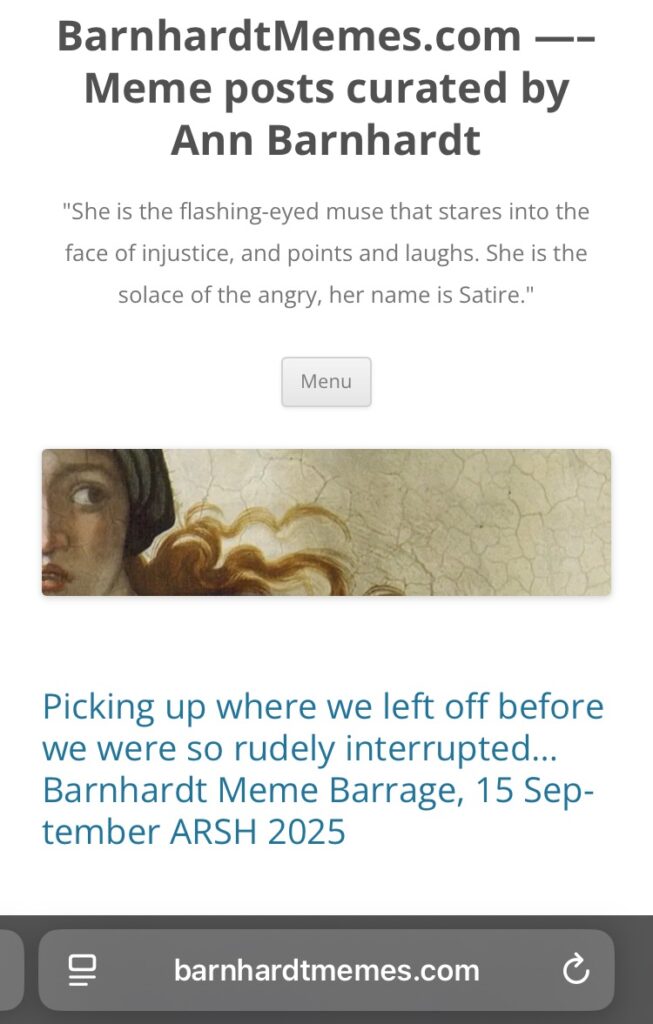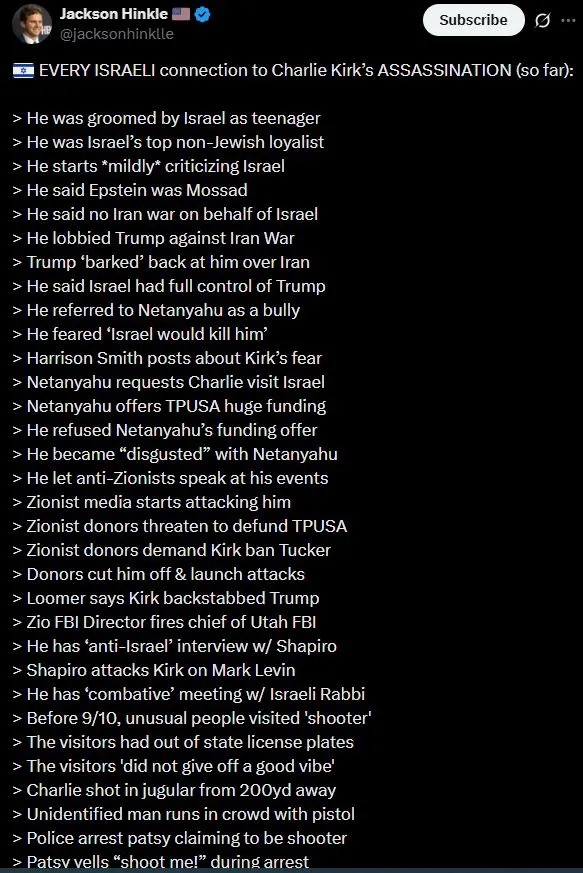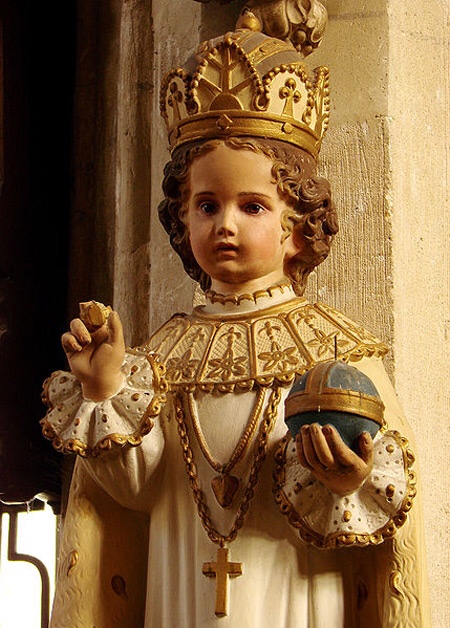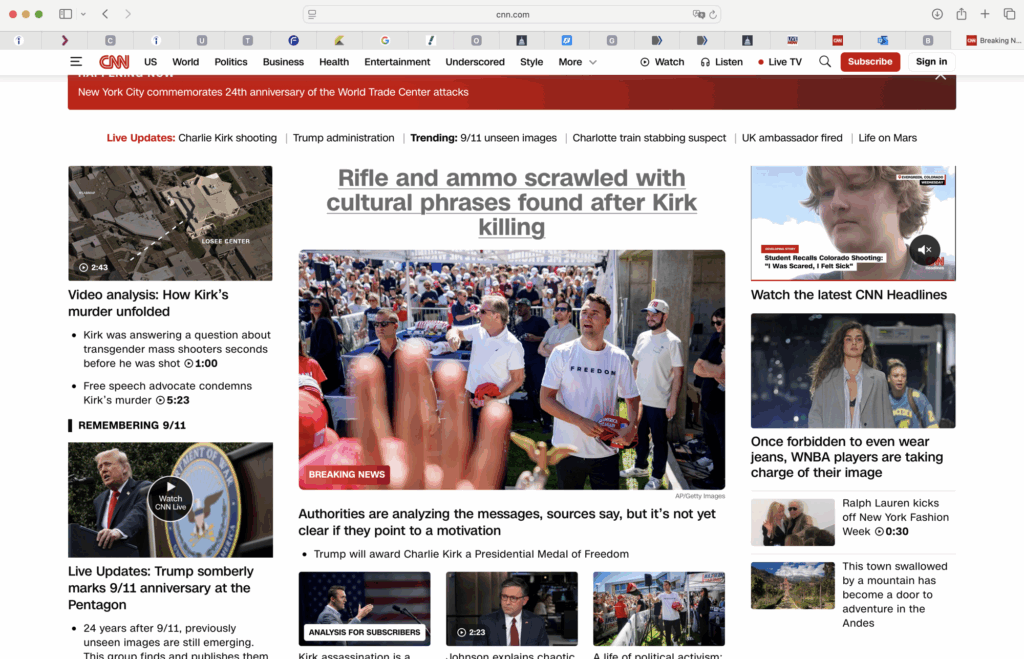Cardinal Burke can be contacted through his website, and through Twitter:
Cardinal Burke’s Website Contact Page
Cardinal Burke’s Twitter page:
https://x.com/cardinalrlburke
Here is the Contact Page of the Summorum Pontificum Pilgrimage:
https://it.summorum-pontificum.org
St. Peter’s Basilica was gravely, notoriously desecrated for the SECOND TIME on Saturday, September 6th, ARSH 2025 when a mob of militant, unrepentant sodomites marched on the Basilica, entered through the Holy Door, and desecrated the Petrine Basilica with satanic signs and attire, including a satanic multicolored sodomy cross, a backpack with the slogan F*CK THE RULES, the battle cry of satanism (“Non serviam” and “Do what thou wilt shall be the whole of the law”), and their comportment, including transvestitism, hand holding, touching and kissing, all after having heard a sacrilegious Mass and sermon at the Church of the Gesù in which a sodomite bishop, at the DIRECT BEHEST of Antipope Robert “FtR” Prevost, made a declaration of war and activation switch for vengeance for God’s just destruction of the cities of Sodom and Gomorrah and for the Church’s immemorial, immutable and infallible teaching that willful sodomy and transvestitism are one of the four grave sins that cry out to heaven for God’s vengeance, and are CAPITAL CRIMES according to both Natural and Divine Law. Less than a week later a man who lives with and sodomizes another man who masquerades as a woman and dresses as an animal for the purposes of satanic ritual sodomy assassinated Charlie Kirk who had made statements critical of sodomy and transvestitism, in particular with regards to children.
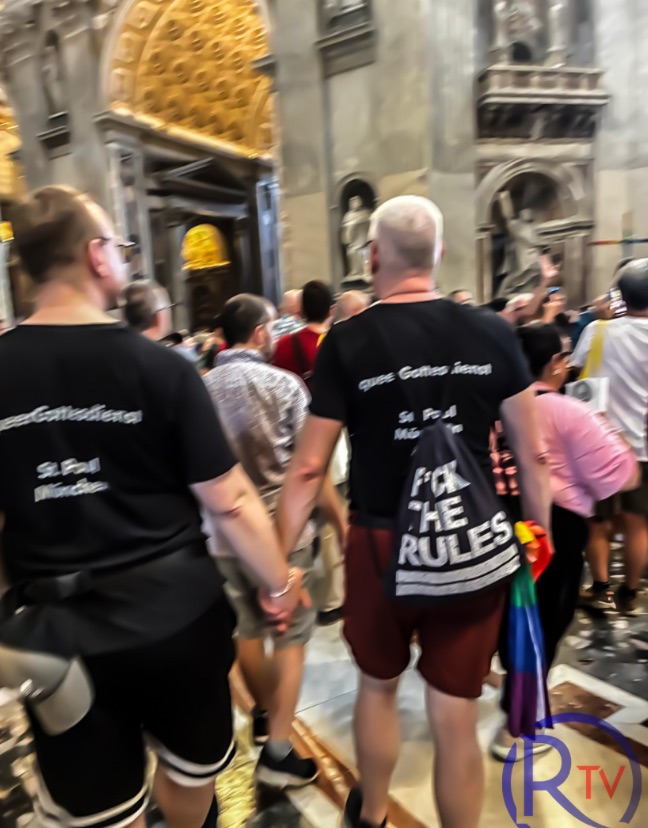
This desecration of BOTH the Petrine Basilica and the Church of the Gesù came nearly SIX YEARS after Antipope Bergoglio ordered the desecration of the Petrine Basilica with the cult worship of the Pachamama demon, which gives every appearance of being an alias of Lucifer himself, by placing a ritually cursed totem representing the Pachamama/satan upon the high altar of St. Peter’s as a witch ritually processed the Pachamama/satanic totem into the Basilica.
Here’s the text of Canon Law from the 1911 Code. Emphases mine:
Canon 1173 (1983 CIC 1211) Cross-Ref.: 1917 CIC 2329
§ 1. A church is violated only by the below-listed acts, provided they are certain, notorious, and were placed inside the church:
1.° The delict of homicide;
2.° An injurious and grave flow of blood;
3.° Impious and sordid use to which the church was put;
4.° Burial of an infidel or an excommunicate after a declaratory or condemnatory
sentence;
§ 2. A violated church, but not the cemetery, even if it is contiguous, can be considered violated, and vice versa.
Canon 1173 (1983 CIC 1211)
§ 1. In a violated church, before it has been reconciled, it is nefarious to celebrate the divine office, to minister the Sacraments, or to bury the dead.
§ 2. If the violation occurs at the time of the divine office, these cease immediately; if [it was] before the canon of the Mass or after communion, Mass is dismissed; otherwise, the priest shall continue the Mass until communion.
Canon 1174 (NA)
§ 1. A violated church is to be reconciled as quickly as possible according to the rites described in the approved liturgical books.
§ 2. If there is doubt about whether a church has been violated, it can be reconciled as a precaution.
Note the words of the Canon, folks. It is NEFARIOUS to celebrate the Sacraments, of which the Holy Sacrifice of the Mass is supreme, in a desecrated church until it has been reconciled. Note how churches are addressed in Canon Law and in the Ritual as personified, and thus a church is “reconciled” just as we are reconciled to God in the Sacrament of Confession.
Furthermore, it is absolutely scandalous that the Summorum Pontificum organizers are having the monstrous, notorious faggot Cardinal Matteo Zuppi preside at the Pontifical Vespers to open the event. ++Zuppi is openly pro-sodomy and transvestitism, and has also publicly declared that any person who commits euthanasia suicide in the Archdiocese of Bologna (mortal sin as one’s last act, spitting in God’s face and demanding to “be like God” as satan said in The Garden) and is denied a Catholic funeral Mass of the Resurrection (a de facto canonization), the he, Zuppi, will personally celebrate the funeral. Also, did I mention that Zuppi is a GIANT, OPEN, NOTORIOUS, FLAMING SODOMITE??
The organizers of the Summorum Pontificum Pilgrimage are FULLY aware of what Zuppi is (a faggot) and what he is NOT (a Catholic), and yet they BRAG about his participation as a twisted form of virtue signaling. This is GRAVE scandal. Look at Marquant’s words: “We are very proud and honored by the participation of the Cardinal of Bologna… it is an eloquent sign of peace and charity among all Catholics.”
MY. WHAT A VERY, VERY ODD THING TO SAY. Why WOULDN’T one be at peace with a Cardinal Prince of the Church? Oh yeah, because he is a RAGING SODOMITE and an arch-heretic who militates for SUICIDE, and Marquant knows this perfectly well, and prides himself (that word just keeps popping up, doesn’t it?) on his open flirtation and PUBLIC ASSOCIATION with sodomites at the highest levels of the Antichurch.

And NO, Cardinal Burke celebrating Mass in the Petrine Basilica will NOT NOT NOT reconcile the Church. In fact, it will be exactly the opposite. It will be, per the Canon itself, NEFARIOUS, and will cause more scandal as TOLERANCE of SODOMY and luciferian acts of desecration of not just any church, but St. Peter’s Basilica itself, and blown off as no big deal, requiring nothing more than saying Mass… which Canon Law made clear is absolutely prohibited until the church is ritually purified ACCORDING TO THE RITUALE OF THE CATHOLIC CHURCH.
For the sake of thoroughness, here is THE RITUAL that MUST BE PERFORMED to Reconcile a profaned church. Please contact Cardinal Burke and make ABSOLUTELY CERTAIN that he knows that the Petrine Basilica must be ritually reconciled, and that to celebrate the Mass in an unreconciled, profaned church is an act of NEFARIOUS scandal.
Also please contact the Summorum Pontificum organizers, and any of the associated organizations listed on the Summorum Pontificum website. This event is not scheduled to occur until the last weekend of October, so there is plenty of time to A.) Organize the reconciliation Ritual of St. Peter’s or B.) change venues to a church that has NOT been publicly and notoriously desecrated and C.) DISINVITE the scandalous heretic and sodomite ++Zuppi from the Pontifical Vespers. I’m sure any priest involved with the Pilgrimage would be happy to hear Zuppi’s confession of his heresy and promotion of sodomy, suicide and human trafficking (Zuppi is a head and principal patron of the massive human trafficking racket “Sant’Egidio”.)
The bishop blesses water according to the usual formula of the Rituale Romanum, standing near a faldstool which is set up for him on a carpet in the middle of the cemetery, or at the doors of the church. He then intones the antiphon, “Thou shalt sprinkle me, o Lord, with hyssop, and I shall be cleansed: thou shalt wash me, and I shall be made whiter than snow.” The choir continues it, and then sings Psalm 50 Miserere from which it is taken, with Gloria Patri at the end, and repeats the antiphon.
Meanwhile, the bishop sprinkles holy water throughout the spaces outside the church, alternating between the walls of the church itself and the earth of the cemetery, and especially in the place where the act of profanation took place. Returning to the faldstool, he then says the following prayer, (also used in the blessing of a cornerstone and the dedication of a church.)
Almighty and merciful God, who hast given to Thy priests above others such great grace, that whatsoever is done worthily and perfectly by them in Thy name, is believed to be done by Thee; we ask Thy immense clemency, that Thou may visit what we are now about to visit, and bless + all that we are about to bless; and at the entrance of our humility, by the merits of Thy Saints, may the demons be put to flight, and the Angel of peace come in. Through Christ our Lord. R.Amen.
He then says with the major ministers “Let us pray. Let us kneel. Arise” and the following prayer, a modified version of the prayer “Aufer a nobis” which is said at the beginning of the Mass.
Take away from us all our iniquities, we beseech Thee, O Lord, that we may be worthy to enter these places to purify them unto Thy holy name. Through Christ our Lord. Amen.
If the cemetery is also to be reconciled, he then says with the major ministers again “Let us pray. Let us kneel. Arise” and the following prayer.
Kindly Lord, who didst will that the potter’s (figuli) field be bought as a burying place for strangers; we ask, deign Thou to remember this Thy most clement mystery. For Thou, o Lord, art our maker (figulus), Thou the field of our rest, Thou art the price of this field; Thou gavest also and did receive; Thou didst grant us to rest of the price and in the price of Thy life-giving blood. Therefore, o Lord, who art the most clement forgiver of our offenses, a most patient judge, most abundant above all things in the mercy of Thy judgment, that hidest the judgment of Thy just severity behind the mercy of Thy holy redemption, be present to harken to and effect our reconciliation; and of Thy kindness, purify and reconcile this cemetery, the resting place of Thy pilgrims who await the sojourning in the heavenly fatherland; and forbearing condemnation, raise and glorify the bodies of those who are or will be buried here from the power and compassion of Thy resurrection, to the glory of incorruption. Who art to come to judge the living and the dead, and the world in fire. R. Amen.
The cantors now begin to sing the Litany of the Saints; the bishop enters the church with the clergy, and comes to a faldstool set before altar, where he kneels. After the invocation, “That Thou may deign to grant eternal rest to all the faithful departed”, the bishop rises, and sings the following additional invocations, making the sign of the Cross over the altar, the church and the cemetery at the places marked. (The word ‘cemetery’ is omitted if only the church is being reconciled.)
That Thou may deign to cleanse and recon + cile this church, and this altar and cemetery. R. We ask Thee, hear us.
That Thou may deign to cleanse, recon + cile and sancti + fy this church, and this altar and cemetery. R. We ask Thee, hear us.
That Thou may deign to cleanse, recon + cile, sancti + fy and conse + crate this church, and this altar and cemetery. R. We ask Thee, hear us.
The Litany being finished, the bishop rises and says with the major ministers “Let us pray. Let us kneel. Arise” and the following prayer. (This prayer is not in the Missal of St. Pius V, but is found in some medieval Missals as the collect of the Mass of the Presanctified on Good Friday. It was added to the liturgy of Good Friday in the 1955 reform of Pope Pius XII.)
O God who, by the Passion of Christ, Thy Son, our Lord, didst loosen the bonds of death, that heritage of the ancient sin unto which the whole race of later times did succeed: grant in Thy mercy that we, being conformed to Him, having born the likeness of our earthly parent of nature’s necessity, so by sanctification may bear the likeness of heavenly grace. Through the power of the same Christ our Lord, Thy son. Who liveth etc. R. Amen.
The bishop now makes the so-called Gregorian water, a special form of holy water which is mixed not only with blessed salt, but also blessed ashes and wine. The blessing is done it exactly the same way as it is done during the dedication of a church, from the three-fold “Deus, in adjutorium meum intende” to the concluding prayer, “Almighty, everlasting God, creator and preserver of the human race.” (The encomium of the water with which the blessing ends during the dedication of a church is omitted.)
The bishop then intones the antiphon, “Let God arise, and let his enemies be scattered: and let them that hate him flee from before his face,” the first words of psalm 67 Exsurgat Deus. The choir continues it, and then sings the last eleven verses of the same psalm, repeating the antiphon after each verse. (The same chant is used during the dedication of a church, at the consecration of the altar.) While this is sung, the bishop goes around the church three times, sprinkling it with the Gregorian water, first on the upper part of the walls, second, on the lower part, third on the pavement, and especially in the place where act of profanation took place.
He then returns to the sanctuary of the church, and facing the altar, says the following invocation.
Dearest brethren, let us humbly beseech God, that forgiveth crimes, washeth away every pollution, God, who purified the world corrupted by original sins in the glory of His coming; that He may come to us and mightily fight against the snares of the raging devil; so that if anything be stained and corrupted in this place by his cunning, that daily longs for and pursueth man’s destruction, it may be cleansed by the mercy of heaven. For as it belongeth to him to break what is solid and perfect, so belongeth it to our Maker, to restore what is fallen, stay that which swayeth, and purge what is corrupted. Who with the Father and the Holy Spirit liveth and reigneth, God.
This segues into the preface dialogue, and the following preface.
Truly it is fitting and just… : Whose measureless goodness, as it had no beginning, so also shall have no end. Who being full of holiness divine and natural, choose rather to restore in us what has been lost, than to smite what would otherwise perish. And if negligence polluteth anything, or wrath commit offense, or drunkenness disturb, or lust destroy, this, O Lord, Thou bearest with patience and clemency; so that Thou might purify by grace, before Thou strikest in wrath. And caring for the work Thou createst, Thou choose rather to lift up what lieth low, than to punish and condemn. We humbly beseech Thee, o Lord, that Thou may look in peace upon this Thy dwelling place, and by the infusion of heavenly grace purify Thy altar, that hath been polluted by the harm of the pursuing enemy; and having purified it, take possession thereof, and keep it hereafter that it never be stained again. Henceforth let every spiritual wickedness depart and be driven out: let the envy of the ancient serpent be destroyed, and the devil’s throng with all its deceits be driven away. Let him bear away with him the stain which he brought in, and since he is destined to eternal punishments, let him gather the seeds of his works with him, that they may perish. Let the guilt of the contamination which has now passed from this place incur no further harm, let there remain nothing which has been polluted by the fraud of the enemy, since it hath been purified by the infusion of Thy spirit. Let the pure innocence of Thy Church rise again, and the luster of innocence hitherto stained, rise again unto glory, since it hath received Thy grace: and so may the crowds of faithful peoples here assemble, and pouring forth their prayers of petition, know that they have received what they have ask for.
The long conclusion is said in a low voice.
The bishop now goes up to the altar, and intones the antiphon, “I will go in to the altar of God: to God who giveth joy to my youth.” The choir continues it, and then sings Psalm 42 Judica me from which it is taken, without Gloria Patri at the end, and repeats the antiphon. (During the dedication of a church, this is sung at the beginning of the consecration of the altar.) When it is finished, the bishop says with the major ministers “Let us pray. Let us kneel. Arise” and the following prayer. (This prayer is also said at the conclusion of the blessing of a church’s corner-stone, and during the dedication, at the conclusion of the translation of the relics.)
O God, who of Thy clemency and kindness art present in every part of Thy dominion to purify it, hear us, we beseech Thee, and grant that henceforth, the building of this place remain inviolable: and may the society of all the faithful, which Thee imploreth, merit to receive the benefit of Thy favor. (short conclusion.)
The bishop then intones the antiphon “Confirm, o God, what thou hast wrought in us, from Thy holy temple, which is in Jerusalem.” The choir continues it, and then sings the whole of Psalm 67 Exsurgat Deus from which it is taken, with Gloria Patri at the end, and repeats the antiphon. (This is also said towards the end of the dedication of a church, after the consecratory preface.) The bishop then says the following prayer.
Let us pray. O God, who didst call Thy Holy Church, gathered from all the ends of the world, through the wondrous mystery of Thy (wounded) side, the mother of all nations, and didst adorn Her by the merits of Thy holy martyrs, even Her that is represented in the diversity of peoples; bless +, o Lord, we ask Thee, helped by Thee and by the prayers of Thy Saints, both the altar, that is adorned with their relics, and the church, and sanctify the prayers of Thy faithful which they devoutly offer to Thee within it. Who with God the Father… R. Amen.
The bishop then imparts a solemn blessing to the people, and if he wishes, prepares to say Mass; otherwise, he may have another priest say it for him. In either case, the following prayers are added to the Mass of the day, under a single conclusion.
Collect O God, who said ‘My house shall be called a house of prayer’, deign Thou to cleanse and sanctify this house that has been contaminated by the filth of the faithless; mercifully hear the prayers and supplications of all who cry out to Thee in this place, and kindly receive them.
Secret May this sacrifice we ask Thee, o Lord, purify this place of all uncleanliness, and render acceptable to Thee always and everywhere our supplications.
Post-communion Receiving o Lord, the gifts of the eternal salvation, we humbly beseech Thee, that this temple and cemetery, cleansed from the contamination of the faithless, may remain sanctified by Thy blessing, and our hearts, separated from all the filth of vice, be ever devoted to Thee.

